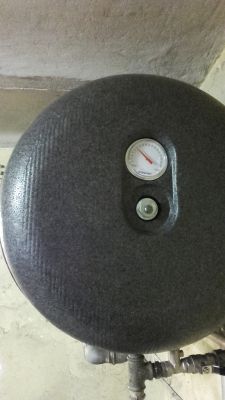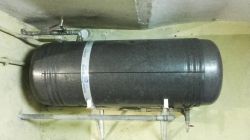FAQ
TL;DR: In a 10‑year add‑on DHW system, morning cold water traced to a hidden leak—"I diagnosed a leak of hot water in the wall." Replacing a 100 L tank with 140 L didn’t help; fix flow, venting, or leaks first. [Elektroda, Grzegorz Czapka, post #17032263]
Why it matters: This FAQ helps homeowners fix morning no‑hot‑water, slow heat‑up, gurgling, and mixing in indirect cylinders.
Quick Facts
- Capacity change: Old 100 L to new 140 L cylinder, same symptom—root cause wasn’t volume but flow/leak. [Elektroda, Grzegorz Czapka, post #17030535]
- Overnight 22:00–05:00 with the stove off produced cold taps, confirming off‑cycle heat loss. [Elektroda, Grzegorz Czapka, post #17030348]
- Sludge‑restricted boiler feed pipes mimic a valve opened only 1/4, slowing heat transfer. [Elektroda, Rezystor240, post #17030516]
- Incorrect venting and near‑horizontal runs trap air; the boiler return should be warm during heating. [Elektroda, BANANvanDYK, post #17032222]
- Leak check: With all taps closed, watch the water meter; any movement signals unwanted DHW flow. [Elektroda, Rezystor240, post #17031866]
Will a larger cylinder stop my morning no‑hot‑water problem?
Not by itself. You replaced 100 L with 140 L and the issue persisted. Volume does not fix circulation faults or leaks. Fix root causes first, then size storage to demand. Two showers emptied the tank because heat input was restricted. Larger tanks can cool more if losses continue. [Elektroda, Grzegorz Czapka, post #17030535]
What causes DHW to go cold overnight when the pump or stove is off?
Thermosiphon (gravity circulation) can dump cylinder heat into radiators at night. Unvalved circuits let warm water rise and cool. "You didn’t have hot water in the morning because the boiler cooled by gravity." Add proper venting and flow control to prevent this. [Elektroda, gersik, post #17031620]
Why did turning off the mains feed to the boiler keep water hot overnight?
Closing the cold feed stopped unwanted flow through a leak or cross‑connection. With supply shut, the tank stops losing heat into fresh mains. The same test also isolates mixer backflow. Morning hot water after closing the feed strongly indicates a DHW‑side leak or crossflow. [Elektroda, Grzegorz Czapka, post #17031757]
How can I use my water meter to detect a hidden DHW leak?
Use this quick test.
- Turn off all taps and appliances.
- Watch the water meter; any movement means unwanted flow.
- Leave the system off‑cycle; if the meter turns, suspect a hidden hot‑water pipe leak.
"Water flows through the boiler all the time" when a hidden leak exists. [Elektroda, Rezystor240, post #17031866]
Could a mixer tap be cross‑connecting hot and cold and cooling my tank?
Yes. A leaking or faulty mixer can cross‑feed cold into hot, bleeding heat from storage. This creates silent overnight cooling and lukewarm taps. It mimics a constant draw with taps closed. Isolate suspect mixers to test for crossflow. [Elektroda, BANANvanDYK, post #17032222]
Why are my boiler pipes hot, yet hot water turns lukewarm soon after use?
That pattern points to restricted heat transfer on the boiler side. Sludge can insulate pipes and choke the circuit, like a valve opened only 1/4. The DHW shell then cools faster than the boiler can reheat it. Inspect and flush boiler feed and return pipes. [Elektroda, Rezystor240, post #17030516]
How do I vent a double‑jacket (mantle) tank loop correctly?
Place a vent at the highest point of the boiler supply. If the supply riser ties in below the peak, air traps there. Near‑horizontal runs worsen air locks and noise. Correct vent placement restores silent, stable heating. [Elektroda, BANANvanDYK, post #17030428]
Do I need a pump with a controller for this setup?
Your system runs the CH pump manually without a controller. Adding a controller automates pump starts at a setpoint and DHW priority. That improves consistency and reduces timing errors. It pairs well with Grundfos or Wilo circulators. [Elektroda, Grzegorz Czapka, post #17030408]
What quick workaround can stop gravity cooling overnight?
Close the radiator return so flow only short‑loops between stove and boiler. This kept hot water until morning in the thread. Also, for diagnostics, close the DHW cold feed to check for leak‑driven losses. Re‑open valves before normal operation. [Elektroda, Grzegorz Czapka, post #17031757]
What does gurgling or “water pouring” in the boiler mean when the pump runs?
It signals air entrained in the mantle circuit or poor venting. The old tank gurgled constantly; the new one on pump start. Air pockets reduce heat transfer and cause temperature swings. Improve vent placement and purge the loop thoroughly. [Elektroda, Grzegorz Czapka, post #17030493]
Could the DHW tank be leaking internally and mixing with CH water?
Unlikely without visible CH overflow. If the jacket perforates, CH volume rises and overflows the vent or expansion. As noted, you would notice that symptom quickly. Use this to rule out internal mixing before replacing tanks. [Elektroda, gersik, post #17031620]
Why did this issue appear after years of working fine?
Aging pipework develops hidden leaks or restrictions after long service. This 30‑year installation with a 10‑year boiler add‑on finally leaked in a wall. The leak bled off heat and mimicked use. Pipe repair restored morning hot water. [Elektroda, Grzegorz Czapka, post #17032263]
Why should the boiler return be warm during heating?
A warm return indicates flow through the boiler loop and active heat exchange. If the return stays cool, air or layout is blocking circulation. This is a quick diagnostic when reviewing an installation. Fix the venting and pipe slope to restore return warmth. [Elektroda, BANANvanDYK, post #17032222]
What was the final root cause and fix in this thread?
A hidden hot‑water pipe leak in a bathroom wall. The leak continuously drew heat from the cylinder, leaving cold taps by morning. After diagnosis, a bathroom renovation and pipe repair were planned. The isolation tests led to the discovery. [Elektroda, Grzegorz Czapka, post #17032263]





